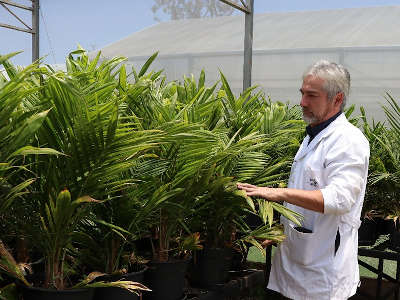In addition to being the source of palm oil and palm kernel oil often included in vegetable oil products, this oil can also be used in the production of biofuels like biodiesel.
Manoel Teixeira Souza Júnior is a researcher in Brazil who works with oil palm plants. The work of his team was recently published in Crop Science, a journal of the Crop Science Society of America.
“There are two different species of oil palm plants,” explains Souza Júnior. “The African oil palm is domesticated and grown commercially. The American oil palm is not domesticated, but it has many desired traits like high oil quality and resistance to disease.”
The goal of Souza Júnior’s work is to organize and describe the collection of American oil palm plants at the Brazilian Agricultural Research Corporation, Embrapa. The collection, known as the germplasm bank, contains a wide variety of oil palm plants with lots of genetic diversity.
“In order for plant breeders to efficiently use the American oil palm in an oil palm breeding programs, it was imperative to further characterize our collection,” explains Souza Júnior. “The results of our research will allow improvements in the collection, conservation and characterization of the plants in the germplasm bank.”

Manoel Souza Jr. in a greenhouse with oil palm plants in Brazil.
To make the collection of oil palm plants more usable, researchers evaluated the genetic codes of each plant. They searched for genetic markers, which are short, identifiable DNA sequences that code for specific traits.
Understanding the similarities and differences within the genetic codes of each plant is important. It helps breeders understand which plants can be most useful when they are looking to breed for certain qualities.
It also allows the research team at Embrapa to get rid of any plants in the collection that aren’t unique. “The current collection contains close to four thousand American oil palm plants, and our results show it could be reduced to about 20% of its size,” explains Souza Júnior.
Farmers are always looking for new varieties of oil palm to grow with better oil yield, oil quality and tolerance to stress. Plant breeders can now use the germplasm bank collection to incorporate desired traits that already exist within the American oil palm gene pool into plants that are grown commercially.
There are two main characteristics that breeders are using from the American oil palm to improve commercial varieties of the African oil palm. These include better oil quality and resistance to the fatal yellowing disease.
Click here to see more...